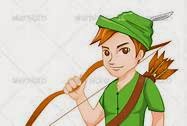I recently took a break from
my World War II mystery series to write a contemporary romance set in
Nottingham, England. I began my research and quickly got caught up in
the history of the area. The town is famous for its link to Robin
Hood, and I will get back to that in a moment, but I also learned
that Nottingham gained worldwide recognition for its lace-making and
bicycles during the Industrial Revolution. Well before that
Nottingham Castle was the site of a siege when King Richard I
(Richard the Lionheart) returned from the crusades and found his
brother John ensconced having declared himself king. Several hundred
years later it was the rallying point for Charles I during the
English Civil War. And in the 15th Century Nottingham
became the center of an export trade in religious sculptures made
from Nottingham alabaster. More recent history includes Nottingham
born ice dancers Torvill and Dean who won Gold medals with perfect
scores at the 1984 Winter Olympics.
 Although my story is set in
the present I wanted to include elements of the past associated with
Robin Hood. That was easier said than done. As it turns out, scholars
are not sure who the real Robin Hood was, or if there was a real
Robin Hood. Intrigued, I searched the internet and visited my local
library checking out numerous fiction and non-fiction books about
this elusive legendary character. Here's a little bit of what I
found:
Although my story is set in
the present I wanted to include elements of the past associated with
Robin Hood. That was easier said than done. As it turns out, scholars
are not sure who the real Robin Hood was, or if there was a real
Robin Hood. Intrigued, I searched the internet and visited my local
library checking out numerous fiction and non-fiction books about
this elusive legendary character. Here's a little bit of what I
found:
In 1225 a man fled from
justice in Yorkshire, and his name was recorded as Robert Hod,
fugitive. From 1228 onward, the names 'Robinhood', 'Robehod' or
'Robbehod' occur in the rolls of several English Justices. And
between 1261 and 1300, there are at least eight references to
'Rabunhod' in various regions across England. It seems the name was
given to known outlaws.
A man named William Smith
was outlawed in 1261. By the time he reappeared in the records in
1262, his name had been changed to Willian Robehod or “Robinhood.”
Or perhaps the real Robin Hood is one of King Edward II's servants,
among whom was a man named Robin Hood. He was employed as a porter,
and some early historians think he may be the original.
The next citation of Robin
Hood is a statement composed by John of Fordun between 1377 and 1384
and revised in about 1440. Robin is represented as a fighter for
Simon de Montfort who led a rebellion against King Henry III:
- “Then arose the famous murderer, Robert Hood, as well as Little John, together with their accomplices from among the disinherited, whom the foolish populace are so inordinately fond of celebrating both in tragedies and comedies, and about whom they are delighted to hear the jesters and minstrels sing above all other ballads.”
This reference identifies him with the historical outlaw Roger
Godberd, who was a supporter of de Montfort, and it would place Robin
Hood around the 1260s. According to some scholars, there are many
parallels between Godberd's career and that of Robin Hood.
By 1439 the name is used in petitions presented to Parliament to describe itinerant felons. Around 1450 the six “original” tales of Robin Hood begin to appear, the earliest of which is a ballad called “Robin Hood and the Monk” It contains many of the elements still associated with the legend, from the Nottingham setting to the bitter enmity between Robin and the local sheriff.
At the same time theories abound that
it is possible Robin Hood has always been a fictional character.
Folklorist Francis James Child was quoted as saying "Robin Hood
is absolutely a creation of the ballad-muse," and this view has
been neither proven or disproven.
Whatever the truth, Robin Hood has all
the makings of a great hero, but is nothing without his friends. Do
you agree?
What an interesting post! I loved Robin Hood as a child and often went about with my friends playing out their exploits. And since I was the oldest and the biggest, guess who got to play Robin Hood. :-)
ReplyDeleteGood post. Thanks for the info.
ReplyDeleteWow. Had no idea there was such a jumble of information behind Robin Hood. Thanks for sharing, Linda. :)
ReplyDeleteThank you so much for sharing this fascinating post! I always enjoyed stories of Robin Hood.
ReplyDeleteGlad you all enjoyed the post. It was fun digging up the information.
ReplyDelete